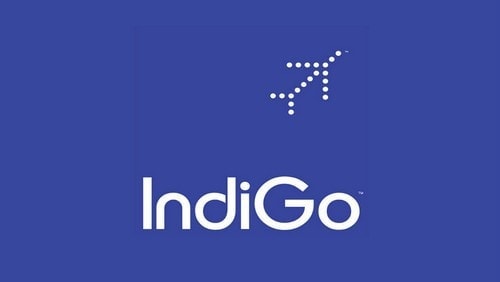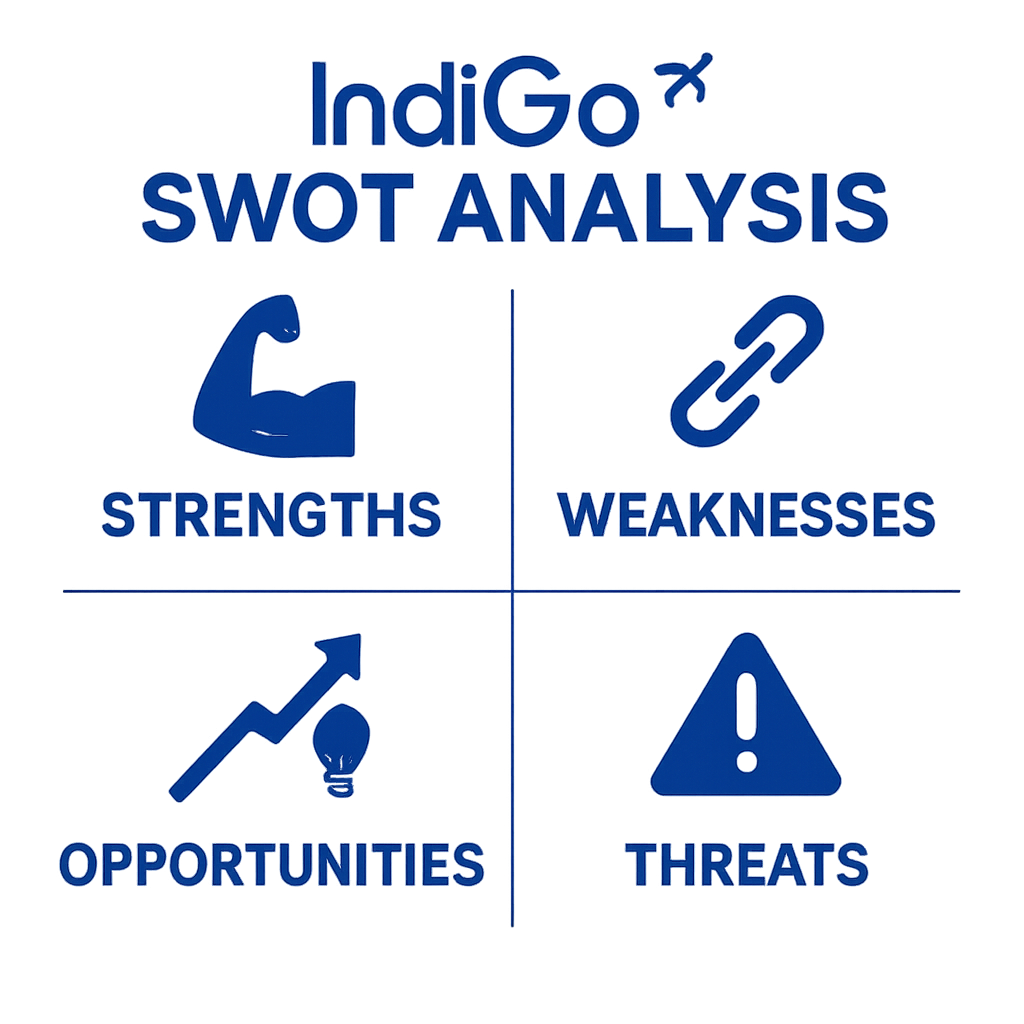IndiGo Airlines, officially known as InterGlobe Aviation Ltd., has emerged as a dominant force in India’s aviation sector. As of 2025, it holds a market share of over 60%, making it the clear market leader among domestic airlines. With a strategy built on cost efficiency, punctuality, and wide network coverage, IndiGo has transformed the way Indians fly.
But behind this soaring success lies a complex interplay of strengths, weaknesses, opportunities, and threats. This blog presents a comprehensive SWOT analysis of IndiGo Airlines, a critical tool for students, entrepreneurs, aviation professionals, and marketers who want to understand what powers IndiGo’s flight and what might bring turbulence.
We’ll break down every aspect—from why it dominates the skies to where its wings could be clipped. Whether you’re researching for a business case study or simply curious about airline strategies, this guide is built for clarity, depth, and practical takeaways.
About IndiGo Airlines

What is IndiGo Airlines?
IndiGo is operated by InterGlobe Aviation Ltd., a public-listed company based in Gurgaon, Haryana. Since its inception in 2006, it has carved out a strong position as India’s most reliable Low-Cost Carrier (LCC).
What Makes IndiGo Unique?
- Affordability: Its pricing model makes air travel accessible to India’s growing middle class.
- On-Time Performance: Year after year, IndiGo ranks at the top for punctuality.
- Widest Domestic Network: With connectivity across over 80 Indian cities and dozens of international routes, IndiGo is the go-to carrier for domestic flyers.
Real Incident Example: In 2023, IndiGo was the only Indian airline to operate continuously during the Cyclone Biparjoy disruptions in Gujarat, rerouting passengers and offering flexibility, reinforcing its brand of dependability.
What is SWOT Analysis?

Understanding SWOT
SWOT stands for Strengths, Weaknesses, Opportunities, and Threats. It’s a strategic planning framework that helps organizations evaluate internal and external factors.
- Strengths: What the brand does well
- Weaknesses: Where it struggles
- Opportunities: Market trends and growth areas
- Threats: Challenges or risks in the industry
Why SWOT Analysis Matters for Airlines
In a high-cost, high-regulation industry like aviation, understanding SWOT helps:
- Craft better marketing strategies
- Make investment decisions
- Improve customer service
- Plan expansion and innovation
When it comes to SWOT analysis of airlines, IndiGo makes for a fascinating case study due to its dominance and distinctive operational model.
Strengths
Market Leadership
IndiGo continues to be the frontrunner in India’s aviation sector, commanding over 60% of the domestic market share. This kind of dominance is unmatched by any other Indian airline.
Real Example: As per DGCA reports, in March 2025, IndiGo transported more than 89 lakh domestic passengers, setting a new benchmark in Indian aviation history.
Cost Efficiency Through a Unified Aircraft Model
IndiGo operates primarily with the Airbus A320 family of aircraft. This decision isn’t just about uniformity—it directly impacts their operations by:
- Making maintenance more straightforward and less expensive
- Cutting down on training requirements for pilots and crew
- Enhancing turnaround time and overall efficiency
This strategy is quite similar to that of Southwest Airlines in the U.S., a successful low-cost carrier that has relied on a single aircraft type for decades.
Unmatched On-Time Performance
If there’s one thing frequent flyers appreciate, it’s punctuality—and that’s where IndiGo shines. The airline consistently ranks among the most on-time carriers in India, making it a top choice for business and time-sensitive travelers.
Rapidly Expanding Fleet
IndiGo isn’t just thinking about today—it’s planning for the future. As of 2025, the airline has over 1,000 aircraft on order, including the advanced A321XLR models that are capable of flying longer, international routes non-stop. This shows its clear ambition to scale up both domestic and international presence.
Financial Recovery and Profitability
The aviation industry took a hard hit during the pandemic, but IndiGo managed a remarkable comeback. By FY2023-24, the airline bounced back with record-breaking profits, driven by a surge in passenger demand and lean operations.
Strong and Consistent Brand Identity
IndiGo’s branding has always been clean, simple, and consistent. The slogan “Go IndiGo” reflects speed, energy, and reliability—qualities that resonate with the average Indian traveler. Whether it’s the color palette, crew uniforms, or the way services are delivered, IndiGo stays true to its core brand values.
Pro Tip for Marketers: If you’re crafting campaigns for aviation or travel, take a cue from IndiGo’s success. Emphasize punctuality, trust, and the idea of connecting Bharat—it’s a messaging strategy that clearly works.
Weaknesses
Lack of Premium-Class Options
IndiGo has stuck firmly to its low-cost model, but the absence of a business class or premium economy means the airline loses out on high-paying corporate passengers. While this keeps fares affordable, it limits revenue from premium segments.
Overdependence on the Domestic Market
A staggering 85% of IndiGo’s routes are domestic. While this has worked well so far, it also exposes the airline to risks from any dip in the Indian economy or shifts in regional travel demand.
Underwhelming Loyalty Program
The 6E Rewards loyalty program hasn’t made the kind of impact other global programs have. It lacks integration with international alliances and doesn’t offer enough incentives to keep frequent flyers loyal—especially those who fly abroad often. In contrast, Air India’s membership in Star Alliance gives it a clear edge in this area.
Limited Onboard Experience
IndiGo’s no-frills model means the inflight experience is quite basic:
- Very few meal choices unless pre-ordered
- No inflight entertainment systems
- Limited legroom, especially on longer flights
This approach works for short-haul flyers, but not for passengers seeking comfort on international or longer routes.
Crew Fatigue and Operational Strain
Reports have emerged of pilot fatigue and scheduling stress, including a near-strike situation in 2024. While IndiGo has addressed these concerns, they highlight the operational pressure of running such a vast fleet on tight schedules.
Refund and Grievance Redressal Issues
During the COVID-19 lockdowns, many passengers complained about delayed or denied refunds. The airline’s customer grievance mechanisms came under fire, and while things have improved, the episode left a dent in its customer trust.
Pro Tip: To sustain its growth and customer goodwill, IndiGo must start investing in better customer service tools and a more rewarding loyalty experience. Even low-cost flyers value recognition and empathy.
Opportunities
IndiGo is no longer just India’s leading domestic airline — it’s setting its sights on global skies and fresh opportunities. Here’s where the next chapter of growth lies:
Global Expansion with A321XLR
IndiGo’s investment in the Airbus A321XLR aircraft marks a major shift. These long-range, fuel-efficient jets are enabling non-stop routes to Europe, Southeast Asia, and Central Asia — a game-changer for a traditionally short-haul airline.
In fact, the airline made headlines in 2024 when it launched direct flights from Delhi to Nairobi and Jakarta, showcasing its serious intent to step into international aviation in a big way.
The Rise of IndiGo CarGo
Freight is the new frontier — and IndiGo isn’t missing out. With e-commerce booming and the pharmaceutical sector expanding, cargo movement is at an all-time high.
IndiGo CarGo is quickly establishing itself in this space, and a strong example came during the 2024 general elections, when the airline transported over 25,000 kg of election material across India within just two days. This kind of agility opens the door for long-term B2B partnerships.
Strategic Codeshare Agreements
Why fly everywhere yourself when you can partner smartly? IndiGo has inked codeshare agreements with global giants like Qatar Airways, Turkish Airlines, and American Airlines. These partnerships allow IndiGo passengers to access a broader global network without the burden of operating those routes directly — a clever way to scale globally without overspending.
Sustainability and ESG Commitments
IndiGo is beginning to take meaningful steps in environmental and social governance (ESG), including:
- Experimenting with Sustainable Aviation Fuel (SAF)
- Redesigning cabin interiors to be lighter and more fuel-efficient
- Going digital with e-boarding passes to cut down on paper waste
As eco-awareness grows among travelers, these efforts will become vital to staying competitive.
Tier-2 and Tier-3 City Expansion
India’s aviation growth story is no longer confined to metros. Cities like Ranchi, Surat, Jabalpur, Bhavnagar, and Udaipur are seeing rising demand, and IndiGo is proactively launching new routes to tap into these under-served markets. This regional connectivity push will further solidify IndiGo’s hold on the domestic front.
Post-Pandemic Travel Surge
Travel is back — and how! With countries like Thailand, Vietnam, and the UAE easing visa norms, and tourists making up for lost time, IndiGo stands to benefit immensely from the rising wave of revenge tourism. Its growing international footprint means more opportunities to attract both leisure and business travelers.
Pro Tip: Now’s the time for IndiGo to double down on marketing its cargo capabilities, green initiatives, and strong regional network with fresh, bold narratives that connect with today’s value-driven flyers.
Threats
Even with strong tailwinds, IndiGo must navigate some serious headwinds in the coming years. Here are the top threats that could affect its smooth flight:
Soaring Aviation Fuel Prices
Aviation Turbine Fuel (ATF) is one of the largest cost components for any airline, often accounting for up to 40% of operating expenses. Fluctuating global crude oil prices, along with high domestic taxation on ATF in India, pose a serious risk to IndiGo’s cost-efficiency model.
Intensifying Competition
The competitive landscape is heating up. Tata Group’s consolidation of Air India and Vistara is aimed at creating a full-service airline with global ambitions. Meanwhile, Akasa Air is ramping up its operations aggressively with a young fleet and a tech-savvy approach. IndiGo will need to sharpen its strategy to stay ahead.
Geopolitical and Airspace Risks
International air travel is subject to the uncertainties of global politics. Conflicts such as the Russia-Ukraine war have already impacted route planning and fuel costs. Any escalation in geopolitical tensions in the Middle East, Asia, or Europe could affect IndiGo’s international operations and profitability.
Airport Infrastructure Constraints
While demand is growing, India’s airport infrastructure is struggling to keep up. Congestion, limited slots, and delays in expanding key airports — like the long-awaited Navi Mumbai Airport — can limit IndiGo’s ability to add flights or maintain punctuality, especially on busy routes.
Regulatory Unpredictability
India’s aviation policy framework can change suddenly — whether it’s fare caps, taxation, or foreign direct investment (FDI) regulations. These unpredictable shifts can disrupt business models, delay expansion, or affect investor confidence.
Pro Tip: IndiGo should stay agile with a diversified route strategy, keep building hedging mechanisms against fuel price shocks, and strengthen its tech ecosystem to adapt quickly to regulatory or operational shifts.
Conclusion
IndiGo’s journey from a modest LCC to India’s leading airline is built on sharp strategy, operational discipline, and clear branding. However, as it sets its sights on global skies, adaptability is the name of the game.
The SWOT analysis of IndiGo Airlines reveals not just what powers its flight today, but what must evolve tomorrow. The airline must move beyond affordability and punctuality to develop premium services, stronger loyalty programs, and a global mindset.
For students and professionals alike, IndiGo is more than a brand. It’s a case study in resilience, innovation, and the dynamic aviation ecosystem.
FAQs
What is IndiGo’s market share in 2025?
As of the first quarter of 2025, IndiGo commands over 60% of India’s domestic aviation market, making it the undisputed leader in passenger volume and route frequency.
Is IndiGo profitable in 2025?
Yes. IndiGo posted record profits in FY24, driven by a surge in post-pandemic travel, efficient fleet utilization, and strategic cost controls.
Who are IndiGo’s biggest competitors?
- Air India-Vistara (Tata Group)
- SpiceJet (limited reach)
- Akasa Air (new entrant, growing fast)
Does IndiGo operate international flights?
Absolutely. IndiGo has expanded globally with direct flights to destinations such as Dubai, Singapore, Bangkok, Nairobi, Jakarta, and Istanbul, with more routes on the way thanks to its long-range aircraft.
Why is IndiGo considered a low-cost airline?
IndiGo follows a no-frills, low-cost model by: Operating a single-class cabin (Economy only)
- Charging for meals and seat selection
- Offering no in-flight entertainment
- Focusing on short-haul, point-to-point routes
What are the 5 core values of IndiGo?
IndiGo operates with the following values at its core:
- Customer Service – Putting flyers first with punctuality and affordability
2. Integrity – Honest operations and transparent pricing
3. Respect – Treating all stakeholders with dignity
4. Empowerment – Enabling employees and frontline staff to take responsibility
5. Responsibility – Towards safety, sustainability, and society
What are the main strengths of IndiGo Airlines?
- Market leader with 60%+ share
- Cost-efficient model with a single aircraft type
- Consistent on-time performance
- Strong domestic network
- Profitable operations and brand trust
What are some of IndiGo’s major weaknesses?
- No business or premium-class offerings
- Weak customer loyalty program (6E Rewards)
- Over-dependence on Indian domestic market
- Basic in-flight services with minimal frills
- Concerns over pilot fatigue and customer support
How is IndiGo taking advantage of opportunities in 2025?
- Introducing long-range aircraft like A321XLR for international routes
- Expanding into cargo through IndiGo CarGo
- Tapping underserved Tier-2 and Tier-3 cities
- Partnering globally through codeshare agreements
- Investing in sustainable aviation and digital solutions
What are the key threats to IndiGo’s growth?
- Rising ATF (Aviation Turbine Fuel) costs impacting margins
- Competition from Tata-backed Air India and Akasa Air
- Regulatory changes and policy unpredictability
- Limited airport infrastructure in Tier-2 cities
- Geopolitical risks affecting international flight paths
How does IndiGo handle competition from Air India and Akasa Air?
IndiGo leverages its strengths — cost control, punctuality, and network coverage — to compete. However, it must evolve its offerings (like loyalty programs and in-flight experience) to defend its market share from full-service and hybrid carriers.
What can IndiGo improve based on this SWOT analysis?
- Introduce premium seating for international routes
- Strengthen 6E Rewards loyalty program
- Improve in-flight and customer service experience
- Continue green initiatives and tech adoption
- Expand international connectivity strategically
Why is SWOT analysis important for IndiGo’s future?
A thorough SWOT analysis of IndiGo Airlines helps identify where the airline is strong, where it needs improvement, and what external factors could drive or hinder its growth — crucial for planning sustainable strategies in a competitive industry.
Is IndiGo planning to introduce business class in the future?
While there is no official confirmation, industry speculation suggests that IndiGo may explore premium seating options on long-haul routes once more A321XLR aircraft are inducted.
How does IndiGo maintain cost leadership?
IndiGo maintains low operating costs by: Using a single aircraft type (A320 family)
- Keeping turnaround time short
- Avoiding frills like free meals or IFE
- Maximizing aircraft utilization
- Efficient ground and crew operations
A passionate blogger and digital marketer, specializing in creating engaging content and implementing result-driven marketing strategies. She is dedicated to helping brands grow their online presence and connect with their audience effectively.

